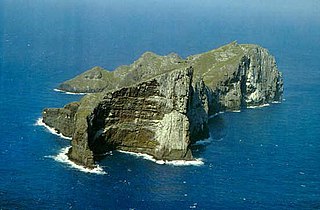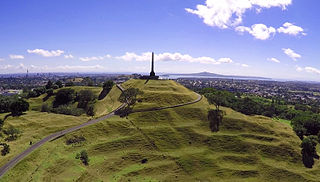
The history of the Pacific Islands covers the history of the islands in the Pacific Ocean.

The Hawaiian Islands are an archipelago of eight major volcanic islands, several atolls, and numerous smaller islets in the North Pacific Ocean, extending some 1,500 miles from the island of Hawaiʻi in the south to northernmost Kure Atoll. Formerly called the Sandwich Islands by Europeans, the present name for the archipelago is derived from the name of its largest island, Hawaiʻi.

Ancient Hawaiʻi is the period of Hawaiian history preceding the unification in 1810 of the Kingdom of Hawaiʻi by Kamehameha the Great. Traditionally, researchers estimated the first settlement of the Hawaiian islands as having occurred sporadically between 400 and 1100 CE by Polynesian long-distance navigators from the Samoan, Marquesas, and Tahiti islands within what is now French Polynesia. In 2010, a study was published based on radiocarbon dating of more reliable samples which suggests that the islands were settled much later, within a short timeframe, in about 1219 to 1266.

Native Hawaiians are the Indigenous Polynesian people of the Hawaiian Islands.

Nihoa, also known as Bird Island or Moku Manu, is the tallest of ten islands and atolls in the uninhabited Northwestern Hawaiian Islands (NWHI). The island is located at the southern end of the NWHI chain, 296 km (160 nmi) southeast of Necker Island. Nihoa is the closest NWHI in proximity to the eight main windward Hawaiian Islands at approximately 240 km (130 nmi) northwest of the island of Kauaʻi. The island has two peaks, 272 m (892 ft) Miller's Peak in the west, and 259 m (850 ft) Tanager Peak in the east. Nihoa's area is about 171 acres (0.69 km2) and is surrounded by a 142,000-acre (57,000 ha) coral reef. Its jagged outline gives the island its name, Nīhoa, which is Hawaiian for "toothed, serrated".

The Makahiki season is the ancient Hawaiian New Year festival, in honor of the god Lono of the Hawaiian religion.

Punaluʻu Beach is a beach between Pāhala and Nāʻālehu on the Big Island of the U.S. state of Hawaii. The beach has black sand made of basalt and created by lava flowing into the ocean which explodes as it reaches the ocean and cools. This volcanic activity is in the Hawaiʻi Volcanoes National Park. Punaluʻu is frequented by endangered hawksbill and green turtles, which can often be seen basking on the black sand.

Puʻuhonua o Hōnaunau National Historical Park is a United States National Historical Park located on the west coast of the island of Hawaiʻi in the U.S. state of Hawaii. The historical park preserves the site where, up until the early 19th century, Hawaiians who broke a kapu could avoid certain death by fleeing to this place of refuge or puʻuhonua. The offender would be absolved by a priest and freed to leave. Defeated warriors and non-combatants could also find refuge here during times of battle. The grounds just outside the Great Wall that encloses the puʻuhonua were home to several generations of powerful chiefs.

A heiau is a Hawaiian temple. Made in different architectural styles depending upon their purpose and location, they range from simple earth terraces, to elaborately constructed stonen platforms. There are heiau to treat the sick, offer first fruits, offer first catch, start rain, stop rain, increase the population, ensure the health of the nation, achieve success in distant voyaging, reach peace, and achieve success in war (luakini).
Patrick Vinton Kirch is an American archaeologist and Professor Emeritus of Integrative Biology and the Class of 1954 Professor of Anthropology at the University of California, Berkeley. He is also the former Curator of Oceanic Archaeology in the Phoebe A. Hearst Museum of Anthropology, and director of that museum from 1999 to 2002. Currently, he is professor in the department of anthropology at the University of Hawai'i Manoa, and a member of the board of directors of the Bishop Museum.

Polynesian navigation or Polynesian wayfinding was used for thousands of years to enable long voyages across thousands of kilometres of the open Pacific Ocean. Polynesians made contact with nearly every island within the vast Polynesian Triangle, using outrigger canoes or double-hulled canoes. The double-hulled canoes were two large hulls, equal in length, and lashed side by side. The space between the paralleled canoes allowed for storage of food, hunting materials, and nets when embarking on long voyages. Polynesian navigators used wayfinding techniques such as the navigation by the stars, and observations of birds, ocean swells, and wind patterns, and relied on a large body of knowledge from oral tradition. This island hopping was a solution to the scarcity of useful resources, such as food, wood, water, and available land, on the small islands in the Pacific Ocean. When an island’s required resources for human survival began to run low, the island's inhabitants used their maritime navigation skills and set sail for new islands. However, as an increasing number of islands in the South Pacific became occupied, and citizenship and national borders became of international importance, this was no longer possible. People thus became trapped on islands with the inability to support them.

Roger Curtis Green was an American-born, New Zealand-based archaeologist, professor emeritus at The University of Auckland, and member of the National Academy of Sciences and Royal Society of New Zealand. He was awarded the Hector and Marsden Medals and was an Officer of the New Zealand Order of Merit for his contributions to the study of Pacific culture history.

Kaunolū Village Site is located on the south coast of the island of Lānaʻi. This former fishing village, abandoned in the 1880s, is the largest surviving ruins of a prehistoric Hawaiian village. The archaeological site is very well preserved and covers almost every phase of Hawaiian culture. It was designated a U.S. National Historic Landmark in 1962 and added to the National Register of Historic Places in 1966.

Loʻaloʻa Heiau is located in Kaupo on Maui. It is one of the few remaining intact examples of a large luakini heiau. Once the center of an important cultural complex, oral tradition attributes the construction of the temple at about 1730 AD to Kekaulike, King of Maui, who lived at Kaupo and died in 1736. Its site number is HASS-50-MA-A28-1. It was excavated in 1931. It was designated a National Historic Landmark in 1962.

Halekiʻi-Pihana Heiau State Monument is a 10-acre (4.0 ha) park containing two important luakini heiau on a high ridge near the mouth of ʻIao Stream in Wailuku, Maui. Both Halekiʻi and Pihana were associated with important Hawaiian chiefs, have been closely studied by archaeologists, and overlook the fertile Nā Wai ʻEhā region irrigated by the Wailuku, Waikapu, Waiheʻe and Waiehu streams. The heiau complex was added to the National Register of Historic Places on 25 November 1985.

Polynesia is a subregion of Oceania, made up of more than 1,000 islands scattered over the central and southern Pacific Ocean. The indigenous people who inhabit the islands of Polynesia are called Polynesians. They have many things in common, including language relatedness, cultural practices, and traditional beliefs. In centuries past, they had a strong shared tradition of sailing and using stars to navigate at night.
Bobcat Trail Habitation Cave is a historic site of Ancient Hawaiian living quarters in a remote interior area of the island of Hawaiʻi.
There have been changing views about initial Polynesian discovery and settlement of Hawaii, beginning with Abraham Fornander in the late 19th century and continuing through early archaeological investigations of the mid-20th century. There is no definitive date for the Polynesian discovery of Hawaii. Through the use of more advanced radiocarbon methods, taxonomic identification of samples, and stratigraphic archaeology, during the 2000s the consensus was established that the first arrived in Kauai sometime around 1000 AD, and in Oahu sometime between 1100 AD and 1200 AD. However, with more testing and refined samples, including chronologically tracing settlements in Society Islands and the Marquesas, two archipelagoes which have long been considered to be the immediate source regions for the first Polynesian voyagers to Hawaii, it has been concluded that the settlement of the Hawaiian Islands took place around 1219 to 1266 AD, with the paleo-environmental evidence of agriculture indicating the Ancient Hawaiian population to have peaked around 1450 AD around 140,000 to 200,000.
There is no definitive date for the Polynesian discovery of Hawaii. However, high-precision radiocarbon dating in Hawaii using chronometric hygiene analysis, and taxonomic identification selection of samples, puts the initial such settlement of the Hawaiian Islands sometime between 940-1250 C.E., originating from earlier settlements first established in the Society Islands around 1025 to 1120 C.E., and in the Marquesas Islands sometime between 1100 and 1200 C.E.

New Zealand's archaeology started in the early 1800s and was largely conducted by amateurs with little regard for meticulous study. However, starting slowly in the 1870s detailed research answered questions about human culture, that have international relevance and wide public interest.















